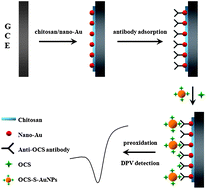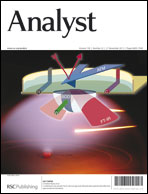An octachlorostyrene electrochemical immunosensor: double amplification strategies with immobilization of nano-Au and Au nanoparticle labels
Abstract
Anti-octachlorostyrene (OCS) antibody was derived from an immune rabbit preparation. An OCS immunosensor was constructed by immobilizing the anti-OCS antibody on a glassy carbon electrode coated with chitosan and gold nanoparticles (AuNPs, ∼5 nm, represented as AuNP05). Large-sized AuNPs (∼90 nm, represented as AuNP90) were used as the electrochemical label. The AuNP90-labeled OCS competes with the target OCS for the limited antibody molecules immobilized on the sensor surface. The amount of bound AuNP90 is inversely proportional to the OCS concentration. OCS was quantified based on the bound AuNP90 which was detected by differential pulse voltammetry (DPV), i.e. the AuNP90 was firstly electrooxidized in 0.1 M HCl to produce AuCl4−, then the reduction current of AuCl4− was detected. The immobilized AuNP05 increases the loading of anti-OCS antibody. Both the immobilized AuNP05 and the label AuNP90 amplify the sensor response. The proposed electrochemical immunosensor exhibits high selectivity, good storage stability, and high sensitivity with a linear range from 1 to 500 nM (R2 = 0.971) and a detection limit of 0.4 nM.


 Please wait while we load your content...
Please wait while we load your content...